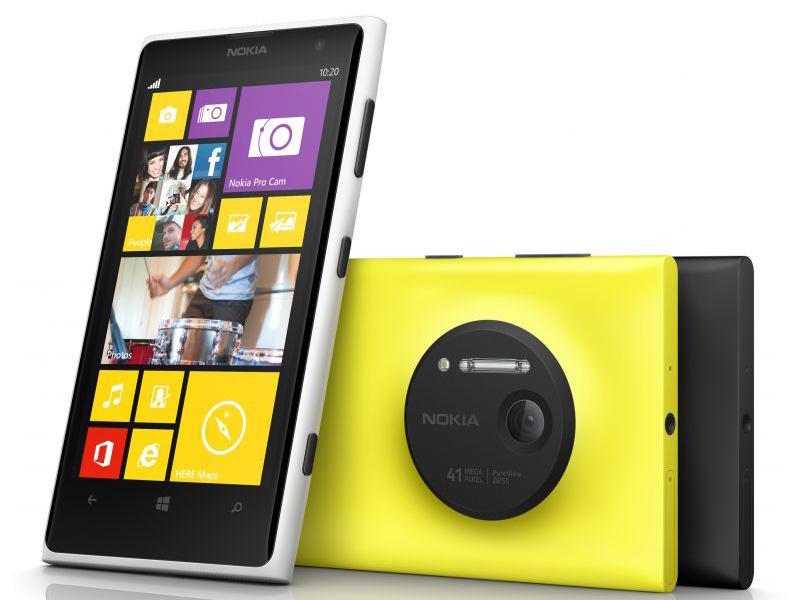
Well, the time has come. What so many people were waiting for, and what so many people had already known was coming, has finally officially been unveiled. Nokia and Microsoft, along with AT&T as an exclusive partner, have teamed up to bring to market another flagship device running Microsoft's Windows Phone 8. Yes, it's another Lumia. No, you wouldn't be at fault if you looked at it from the front and thought it looked like a Lumia 920. But there's plenty going on 'round back that will catch your eye, and make you think twice about calling it anything other than the Lumia 1020.
If you've been keeping tabs on the device previously known as "EOS," then you've got a pretty clear picture of the device that Nokia announced today. The Lumia 1020 as it's affectionately known now, is a Windows Phone device that features a 4.5-inch AMOLED display, with a resolution of 1280x768. On the front, you'll find a 1.2MP wide-angle camera. Inside, there's 2GB of RAM, 32GB of built-in storage, and a 1.5GHz dual-core Qualcomm Snapdragon processor.
It's around back that's getting all the attention, though. It's there that you'll find the 41-megapixel camera, with Xenon *and* LED flashes. It features things like optical image stabilization for both still pictures and video, an f/2.2 lens, and a specific application that Nokia is calling "Pro Camera." This will allow users to fine tune their images, changing settings ranging from the ISO, exposure levels, focus, white balance, among other settings. This app will allow for the photographer to take photos at 38 megapixels, as well as one at 5 megapixels, so that you can share the latter photo easily on social networking sites.
Boom. This is the phone that a lot of people had been waiting for, if not for any other reason then they knew it was coming. It had to be coming. With the focus that Nokia has been putting on the camera as of late, especially with the three previous Lumia devices they have launched, the Lumia 1020 just feels like the inevitable next step. And it's finally here. We finally have all the details. We know when it's coming, which carrier (not that that was any surprise, really) it's launching on, and we know how much it will cost.
Ah, the cost.
So, a lot of the rumors floating around before the final reveal suggested that the full retail price of the Lumia 1020 would be around $600. That turned out to be true. What hadn't been going around all that much was speculation regarding how much it would cost with a new, two-year contract. And apparently for good reason. I'll admit that I was a bit shocked when I saw the device go hand-in-hand with a $299 price tag. It's been awhile since I've seen that.
The question is a pretty obvious one: is the Lumia 1020 too expensive? My initial thought was, "Yes, yes it is," and I may not have jumped off that boat completely quite yet. But, after discussing it a bit, I can see where Nokia is coming from. They're trying to establish a high-end model, and that means going above the Lumia 920, or even the Lumia 928 or 925 for that matter. The Lumia 1020 gets us out of the 9xx series and puts us squarely into a new lineup. A lineup that, if Nokia is going to keep on this train, means that it can only get better from here.
And that's an impressive proposition.
Some would suggest that the Lumia 920 was perfectly fine for the high-end, though. With its 32GB of storage, amazing display, and the 8MP camera, which only got better especially in low-light situations in models like the Lumia 928. The Lumia 9xx series makes sense at the high end when you've got devices like the Lumia 822 or 820. But, at the same time, it's still putting a limit on your choice as a consumer. Adding one additional tier to the family, and giving three obvious choices, makes it easier for a "high-, medium- and low-end" device to exist.
And the Lumia 1020 is a prime example of why it works. While the 1020 may look like a Lumia 920 at first glance, Nokia proves that with the right features tucked inside, a higher price tag can make sense. On July 26, when a customer walks into an AT&T store, they'll see that the Lumia 1020 is $299 with a new contract, but so is the iPhone 5 32GB model. (The Galaxy S 4 costs $249.99). Instead of getting an 8MP camera, or even a 13MP camera in the Galaxy S 4, you'll be getting a 41-megapixel shooter. So, the same storage, the same price, but a better camera.

It's worth the price tag, and I'm basing this entirely off my short time with the 808 PureView a long time ago. If the camera is better than what it used to be, and it used to be fantastic, then it's worth the price tag. It's as simple as that. Plus, you add that camera grip on there, then you've just removed the need for your point-and-shoot camera.
I planned on switching to Windows Phone because of the Lumia 1020 even before they officially announced it, and I'm glad I made that premature decision, because I plan on sticking to my plan. The Lumia 1020 sounds like a great device, and I can't wait to take pictures of my family with that camera.
So tell me, do you think the Lumia 1020 fits nicely at the high-end market, while the Lumia 920 makes a great mid-range device, and the Lumia 820 makes a nice base model? Or do you think the Lumia 1020 is simply too expensive, and that Nokia/Microsoft/AT&T have made a mistake? Let me know what you think!